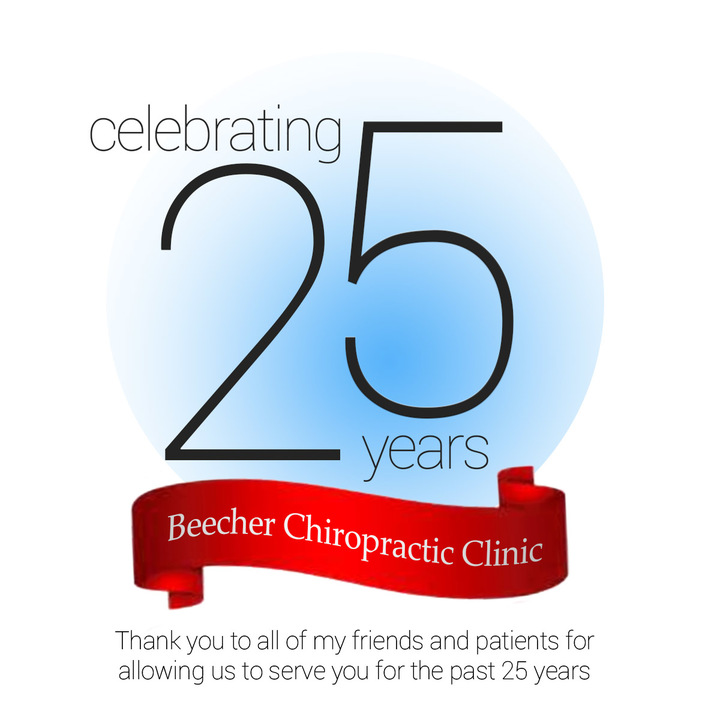25th Anniversary
As Beecher Chiropractic celebrates its 25th anniversary today, I would like to express my deepest gratitude to all of my clients, friends and family. Here’s to many more years as your Houston chiropractor!
Low Back Pain vs. a Low Back Problem: Is There a Difference?
To download a copy of this newsletter, please click here.
Chiropractor near NASA comments: Your “back pain pain” might be a misnomer. We often confuse pain for a problem. Doctors often don’t help matters by not doing thorough examinations, and just offering a prescription of pain pills or anti-inflammatory drugs when the patient comes in with a complaint of pain.
So what is the difference? The pain is part of the problem you are experiencing, but it is not the actual cause-the problem that is producing the pain. If you say you have back pain to a doctor, this should be the starting point for a complete examination to determine its cause. Is it a problem with the disk (a cartilage ligament that separates the vertebrae)? Is the problem more a muscle strain? Do the joints of the spine move in a free and symmetrical pattern?
Have you been examined this way? Was your spine moved around in different planes? Did the doctor poke and press on different tissues of the spine to see if there was swelling (inflammation) or tenderness? Were x-rays taken to see if there was normal alignment and good posture of your spine?
All of these tests help to determine the actual nature of the problem. It’s not enough to just call the pain the problem and leave it that. Sadly, this happens to far too many patients who are left thinking that if they just take something to cover up the pain, it makes the problem go away.
Our clinic is different, we examine to find the cause of your pain, and then provide a treatment plan that can get you back to enjoying your activities with maximum function. If your pain is gone but you still cannot use your back like you used to, then you might want to consider an alternative approach.
Of course, taking pain pills for long periods of time can also lead to undesired side effects such as stomach bleeding. We are very conditioned in society to accept pills as the source of health and longevity. For many patients they are critical to regaining health, but too often they are used as a panacea, especially when it comes to back pain. You should ask questions about a doctor’s approach to getting you well, and whether this fits with your philosophy and preferences.
Dr. Ward Beecher practices at Beecher Chiropractic Clinic at 1001 Pineloch, Ste 700 Houston, TX 77062. You can schedule an appointment at BeecherChiropractic.com or by calling (281) 286-1300. If you have any questions regarding this blog, please comment below!
Carpal Tunnel Syndrome: Gadgets and Alternatives
To download a copy of this newsletter, please click here.
Houston Area Chiropractor Comments: I’ve noticed many patients use gadgets to treat carpal tunnel syndrome. But is this a good choice or another fad? Sometimes our health advice comes from friends, family, and customers at the local health food store. I am sure you were given a persuasive story before buying. Late night TV infomercials are used too often for medical advice. If your carpal tunnel symptoms show up at night, you may have fallen prey to these sales pitches. There are lots of snake-oil salesmen to take advantage of this often debilitating and frustrating condition which affects millions every year.
Copper bracelets and magnets seem to be particularly in style today. But do these and similar gadgets even work?
There are a couple of studies looking at herbs and magnets. According to the research there is very little evidence that these devices do anything at all. There are no studies on copper-so I guess the jury is still out on that question. However, they don’t pass the smell test in my opinion. These gadgets are probably safe, except for making your skin turn a little green from a copper bracelet.
What about yoga? Surprisingly, one clinical trial of 51 patients over eight weeks showed that doing yoga improved carpal tunnel symptoms better than using a wrist splint.
As far as chiropractic care, there is some evidence that mobilization movements can help ease symptoms. In the short term, chiropractic care is at least as effective at reducing pain when compared to taking powerful pain-killing drugs.
The first step is to make sure you are properly diagnosed. There are too many patients who get incorrect diagnoses or have resigned themselves to taking pills for indefinite periods of time.
One important consideration is whether your hand symptoms are from a neck injury. Injury to nerves in the neck and wrist can lead to what is known as double-crush syndrome. The wrist and the neck, needs to be examined to get a thorough diagnosis. There are also rare causes of carpal tunnel syndrome, such as diabetes, which have to be considered.
Dr. Ward Beecher practices at Beecher Chiropractic Clinic at 1001 Pineloch, Ste 700 Houston, TX 77062. You can schedule an appointment at BeecherChiropractic.com or by calling (281) 286-1300. If you have any questions regarding this blog, please comment below!
Whiplash Problems Down the Road
To download a copy of this newsletter, please click here.
Clear Lake Chiropractor comments: Whiplash injuries of the neck and spine commonly occur in motor vehicle collisions. Even minor impacts with little vehicle damage can put significant stress on the spinal ligaments, disks, and delicate nerves. Some people get symptoms right after the accident (which is a very bad sign) but most people feel somewhat unscathed, at least initially.
It’s important to think how spinal injuries can affect you over the long term. When ligaments are injured, there can
be substantial changes over the years, such as arthritis and disk degeneration.
A study in the science journal SPINE (Dec. 15, 1994) looked at fifty patients with MRI and bending x-rays, one and five years after injury. The researchers found that neck pain persisted in 24/50 (48%) patients and radiating pain developed within 6 weeks in 19 patients or 38%. Radiating pain occurs when a disk protrudes and bulges onto a nerve root exiting your spinal column. In patients with these persistent symptoms, the MRI was helpful in showing the disk injury.
Although surgery is considered by many, most patients do well under conservative, even minimal care. It’s important to consider non-surgical options first, since surgery does entail substantial risks, and how well it works is also subject to debate.
X-rays and palpation are used to see the posture of your neck and how the vertebrae move in stressed positions. These tests can help determine how your spine functions and whether the disk is injured and/or also if you have pre-existing signs of arthritis, which can impair how you resist and recover from trauma.
Chiropractic adjustments are directed at reducing pain and improving mobility in spinal areas that are blocked. In general it’s important to keep your neck moving while you recover. Staying in bed and not moving the spine at all are not advised since this can impair recovery. Even patients with severe injuries can have some movements preserved and these should be encouraged.
Because symptoms and even disk disease can show up later, it is important to have a detailed neurological examination following a neck injury. Whiplash trauma is significant, especially when you consider how many patients still suffer years down the road with neck and arm pain. Getting diagnosed properly is the first step to determining what type of care will be best for you.
Dr. Ward Beecher practices at Beecher Chiropractic Clinic at 1001 Pineloch, Ste 700 Houston, TX 77062. You can schedule an appointment at BeecherChiropractic.com or by calling (281) 286-1300. If you have any questions regarding this blog, please comment below!
Benefits of Using Rocktape™
To download a copy of this newsletter, please click here.
Houston Chiropractor Comments: Since I started using Rocktape in my office, the most common question I get is “What is that?” Rocktape is a kinesiology (the study of movement) tape that is stretchy as opposed to rigid. It is
used to help reduce swelling, decrease pain and allow full range of motion of a joint. It is different than the old rigid tape that our high school trainers used to tape our ankles and wrists. The second question that I get is “How does it work?” It works on the body by improving lymph and blood flow to the taped area, it allows the sliding and gliding  between tissue layers and it alters the perception of pain while improving body awareness.
between tissue layers and it alters the perception of pain while improving body awareness.
Kinesiology taping began in the late 1970’s by a Japanese chiropractor named Dr. Kenzo Kase. Most people first became aware of the tape by Lance Armstrong when he was winning his 7 Tour de France’s. Other people became aware of it in the 2008 Olympics when volleyball player Kerri Walsh was shown using it on television. It is currently used by athletes, weekend warriors and active people.
I became a believer in the taping when I tore my calf muscle 2 years ago. With the correct IASTM muscle work and the Rocktape, I was able to get back running without prolonged issues. In my office we use Rocktape on acute neck and back injuries as well as knee, ankle, shoulder, elbow, and wrist injuries.
Rocktape can be used for several days at a time without the need to reapply the tape. You can shower and even swim without worrying about the tape coming off. An additional benefit is that you can purchase a roll of tape and apply it yourself with proper instruction.
Dr. Ward Beecher practices at Beecher Chiropractic Clinic at 1001 Pineloch, Ste 700 Houston, TX 77062. You can schedule an appointment at BeecherChiropractic.com or by calling (281) 286-1300. If you have any questions regarding this blog, please comment below!
Headaches, Hygiene and Pillows
To download a copy of this newsletter, please click here.
Houston Chiropractor comments: We hear about dental hygiene and how to eat right, but when was the last time you considered if you slept well; in a way that does not stress the spine. Most of us know it’s important to avoid head and neck trauma because serious and devastating injuries can occur. Less understood, are how minor and cumulative stresses over time, can affect the soft tissues in the neck.
If you have never suffered a neck trauma, then maintaining good neck habits is less critical. But most of us have had a few kinks in the neck over the years, and we tend to suffer when problems are not prevented in the first place.
Keeping your neck supple and flexible with daily stretches can help many patients. Others may need to do daily controlled exercises to keep the muscles strong. A doctor can advise you on your specific needs. It’s important to be diagnosed properly before starting any stretching or exercising program.
Ever wonder why your neck might be stiff in the morning? Maintaining good spinal hygiene while sleeping is also important. Eight hours of bad posture can be a significant problem.
Because there is naturally an arch formed in the neck when you lay on your back, a pillow can be designed to support the middle of your neck. The best type of pillow is a water filled pillow. These are superior to the typical cervical support pillows which are only good when you are perpendicular to the pillow. The problems arise from those types of pillows when you move during the evening, placing your head at an odd angle. This problem does not arise with water filled pillows since the water can shift with your head allowing optimum support at all times.
Our clinic provides patients with spinal hygiene exercises and advice to care for problems over time. This can be key to you avoiding re-aggravation of your condition and to prevent problems from occurring in the first place. Many headache patients seem to benefit when they pay attention to the stresses on their neck. It can be looking at a computer screen with the head down or something as simple as the type of pillow you use while sleeping.
Dr. Ward Beecher practices at Beecher Chiropractic Clinic at 1001 Pineloch, Ste 700 Houston, TX 77062. You can schedule an appointment at BeecherChiropractic.com or by calling (281) 286-1300. If you have any questions regarding this blog, please comment below!
Low Back Pain: Getting Back Your Balance
To download a copy of this newsletter, please click here.
Clear Lake Chiropractor comments: Our sense of balance comes from a few different areas of the body. The inner ear gives us input on the position of our head and whether we are moving. This is combined with input from the eyes, which gives similar information. Most people think this is where it ends, but the spine is also integral to maintaining proper balance.
Tiny nerve endings in the spinal column send information about position and movement up the spinal cord, and into our brains where it is integrated with information from the ears and eyes. A person can become imbalanced through disease in any of these areas: eyes, ears, and spine. Inner ear infections, but also head and neck trauma can dislodge tiny particles in the inner ear that give us balance feedback. The spine can also be primarily injured through traumas to ligaments and muscles. In addition to neck trauma, patients with low back trauma can also have their balance affected.
Patients with chronic low back pain tend to have more sway to their posture, which means there is less margin for error if one trips or misses a step. There is also reduced response time, which is needed for unexpected events. Part of the rehabilitation of chronic low back pain involves getting back the sense of balance if it has been affected.
You may find when your postural muscles are strengthened, back pain is reduced. Even more important than this, strengthened postural muscles can help prevent falls, which occur more frequently when your sense of balance is affected by disease.
Can you stand on one leg for five seconds or twenty? Have you fallen or had a few near misses in the past month? Have you broken a bone due to a fall?
We can diagnose why you may be suffering from balance problems and low back pain. A home exercise and balance program can be prescribed to make sure your spinal muscles and joints give proper input into the brain. You’ll probably start by standing on one leg, if you can do that, and then progress slowly through more challenging postures, such as bending your knee, or moving one leg around. It’s important that a doctor evaluate you before commencing with balance treatments. You do not want to fall during your exercises.
Dr. Ward Beecher practices at Beecher Chiropractic Clinic at 1001 Pineloch, Ste 700 Houston, TX 77062. You can schedule an appointment at BeecherChiropractic.com or by calling (281) 286-1300. If you have any questions regarding this blog, please comment below!
Low Back Pain & Work Injuries
To download a copy of this newsletter, please click here.
Nasa Area Chiropractor comments: About 1/3 of patients with low back pain will consult a doctor of chiropractic. People who injure their low back on the job also often consult a chiropractor. One study (J Occup Environ med 2007;49:1124;Wasiak R, Kim J, Pransky GS) looked at these on-the-job injuries and how chiropractic care was used. In this report from Massachusetts, about 89% of workers initiated chiropractic care within 30 days of the injury and about half (48%) were done with their care in the same time frame.
At work and during lifting the lower spine and disks are especially vulnerable to injury. Heavy loads or simply awkward or stooped positions can be risks and should be avoided. Of interest, more people tend to injure their back in the first two hours of a work shift. This may be because the disks swell up with water during sleep and are more  pressurized first thing in the morning. Or perhaps we’re not as attentive to lifting with good form, first thing in the morning.
pressurized first thing in the morning. Or perhaps we’re not as attentive to lifting with good form, first thing in the morning.
If you’ve suffered a back injury it’s important to get checked soon so that you have the best chance for getting back on
the job quickly. Bed rest and staying inactive are usually not healthy options for treating the low back. Inactivity can make back sprains worse by causing the muscles to weaken. Walking keeps pressure off of the disks and keeps the muscles engaged. If walking aggravates your pain, then it has to be avoided in the short term. Of course lifting following a back injury has to be limited. It’s important to lift with your legs and to avoid twisting motions.
Chiropractic adjustments are designed to improve the mobility of the spinal joints, improve posture and decrease tension on the delicate ligaments and nerves. In many studies chiropractic care has exceeded the results seen with conventional medical treatments such as medications or surgery.
When a back injury occurs, commonly the vertebrae move out of their normal position from the stretch of the supporting ligaments. Simply leaving the ligaments in this stretched-out position may not be healthful in the long run. Since the ligaments are injured, the vertebral joints tend to move abnormally. This is called a mechanical back problem and is one of the most common diseases of the lumbar spine.
Dr. Ward Beecher practices at Beecher Chiropractic Clinic at 1001 Pineloch, Ste 700 Houston, TX 77062. You can schedule an appointment at BeecherChiropractic.com or by calling (281) 286-1300. If you have any questions regarding this blog, please comment below!
Headaches from the Neck?
To download a copy of this newsletter, please click here.
Chiropractor in Clear Lake City, TX comments: Cervicogenic headache is the term used to describe a headache that has its cause in the neck region. It used to be thought headaches were caused by something in the head itself, but researchers have now learned that neck injuries can produce head pain.
A study from Norway (Acta Neurol Scand 2007;Nov.20; Sjaastad O, Bakketeig LS) showed that about 4% of the population will have this type of headache. Taking medications to cover the pain will not ultimately correct a mechanical neck problem.
The symptoms of a cervicogenic headache are as follows: one-sided head pain and same side shoulder and arm pain. Patients also have limited mobility of the neck region. Rarely a patient may also have a migraine trait such as nausea, vomiting, or throbbing sensations. Because of these different signs from a typical migraine headache a physician may have overlooked the neck as a potential source for the cause of your head pain. Self-diagnosing your headache can be even worse since potentially serious causes of your head pain, such as high blood pressure may go undiscovered and left untreated. In any case it’s unlikely that your headache has been caused by a deficiency of pain pills in your diet. There are also unintended side effects that have to be considered when weighing any health care option.
Another study from Norway (Funct Neurol 2007;22:145; Drottning M, Staff PH, Sjaastad O) looked at causes of cervicogenic headaches, specifically whiplash injuries of the neck. In this study, 587 whiplash patients were followed over a six-year period. About 8% of the whiplash sufferers developed a cervicogenic headache six weeks after the initial trauma. Thirty-five percent of these patients were still suffering six years later.
Our clinic specializes in the treatment spine-caused head pain especially cervicogenic headache. To determine this we have to perform a comprehensive examination of your spine to see if sprains of your cervical or thoracic joints are present and review whether you’ve suffered a trauma in years past that could have affected the posture and mobility of these delicate spinal structures.
For patients who do not go down the road of medications for treating their neck pain in Houston, chiropractic care can be a more healthful option.
Dr. Ward Beecher practices at Beecher Chiropractic Clinic at 1001 Pineloch, Ste 700 Houston, TX 77062. You can schedule an appointment at BeecherChiropractic.com or by calling (281) 286-1300. If you have any questions regarding this blog, please comment below!
Whiplash and Balance
To download a copy of this newsletter, please click here.
Clear Lake City Doctor of Chiropractic comments: As whiplash injuries are studied more and more, the  many health problems that can develop as a result of them are becoming more apparent. Neck sprains are not simple problems like a sprained ankle because the neck is involved in a lot of important duties, not just movement. One such function of the neck is to keep you upright and in balance. Balance is complex and involves coordination between sensations in your inner ear, your eye movements and neurological signaling from your neck, spine and legs. The neck nerves are especially important in this regard. The brain receives inputs from the ears, the eyes, and neck, and determines from these three areas where you are in space, where’ve you been, and where you are going. If any of these areas is affected, then balance is disturbed.
many health problems that can develop as a result of them are becoming more apparent. Neck sprains are not simple problems like a sprained ankle because the neck is involved in a lot of important duties, not just movement. One such function of the neck is to keep you upright and in balance. Balance is complex and involves coordination between sensations in your inner ear, your eye movements and neurological signaling from your neck, spine and legs. The neck nerves are especially important in this regard. The brain receives inputs from the ears, the eyes, and neck, and determines from these three areas where you are in space, where’ve you been, and where you are going. If any of these areas is affected, then balance is disturbed.
You may stumble around more, not really have a sense of where your feet are; you may trip more and in severe cases, you may develop vertigo (a spinning sensation). These symptoms can have a devastating effect on your quality of life, even resulting in nausea.
A study from Europe (funded by an insurance company) (Coll Antropol 2007;31:823) looked at how we sense position of the head following whiplash. The researchers compared whiplash-injured patients to normal healthy people in their ability to sense the position of their head; whether they were rotated or tilted in some way. The results were alarming. Patients with cervical spine injury showed significant impairment of proprioception (sense of position)
Chiropractic care involves trying to normalize joint function of the neck. Adjustments are designed to restore normal mobility and improve the posture of the neck so that it is more balanced. Some patients will need specific exercises, even balance therapy, to help improve their sense of position and keep them from feeling dizzy.
So if you’ve wondered about feeling unsteady, or are not really sure on your feet, this could be a consequence of a whiplash injury. Because both the brain and neck can be injured in whiplash, the symptoms can be quite substantial. Just letting it go and hoping it will go away can create an even longer lasting problem. And bed rest or simply not moving the neck are not good options either, because your neck needs to move to properly heal. Some neck collars can even create more of a problem leading to muscle weakness. They are right for some patients, but not for everyone.
Our clinic specializes in a comprehensive rehabilitation program to help you get past the whiplash injury, and back to the normal quality of life you enjoyed before the trauma.
Dr. Ward Beecher practices at Beecher Chiropractic Clinic at 1001 Pineloch, Ste 700 Houston, TX 77062. You can schedule an appointment at BeecherChiropractic.com or by calling (281) 286-1300. If you have any questions regarding this blog, please comment below!


